The Dachshund
[ad name=”Commission Junction Big Al’s”]
THE DACHSHUND
Origins
Dachshunds are short-legged, long dogs, aptly nicknamed Wiener or Sausage dogs. In German, “dachshund” literally means “badger dog.” In Germany they are also called Dackel; and if they hunt and track, Teckel.(1) They descended from scent hounds, like Bassett Hounds, but show a dogged, persistent personality and terrier-like love for digging. They are the one breed certified to hunt above and below ground.(1)
Historical artwork shows similar dogs hunting in the 1500’s(6), but written references first come from the 1700’s. (2) Original dachshunds were larger, weighing 14 -18kg, and both straight and crook-legged varieties existed. They were also used for fox hunting, locating wounded deer,and hunting larger game in packs. They usually live between 12-15 years, and (6) rank 49th in Stanley Coren‘s Intelligence of Dogs . Because they are small, they are ideal for city or country life. Most are energetic, (1) need lots of exercise and should be taken twice daily for a 10-20min walk. Many behavior problems and a tendency to be overweight are from lack of exercise. (9)(6)
Appearance
They are long-bodied and muscular, with short, stubby legs and have large, paddle-shaped paws, for digging. Their skin is loose so it doesn’t tear and their chest deep, increasing lung capacity for endurance. The snout is long with a big olfactory area. Dachshunds come in three sizes: standard, miniature,and Kaninchen (rabbit). A full-grown standard weighs 6.8 to 13 kg, miniatures less than 5.0kg and Kaninchen, 3.6kg to 4.5kg. (1)
There are three coat types: short-haired (smooth),long-haired; and wire-haired,(1) created by crossing smooth Dachshunds with hard-coated terriers and wire-haired Pinschers. (2) The flap-down ears stop grass seeds and dirt going into the ear and the curved tail allows them to be seen easily in long grass and is used to help haul them out of burrows.(1)
Dachshund coats can be a solid color, spotted (dappled), or single-colored with points. Solid red is the most common, along with black and tan. Pointed dogs can be black, wild boar or chocolate with fawn, tan or cream points. There is also a lighter “boar” red, sable, piebald and brindle. Solid black and chocolate are frowned upon. Their eyes may also be different colors. Blue eyes, partially blue eyes, or one blue eye are called “wall” coloring, but are non-desirable. Dappled eyes are also seen. (1)
Behaviour
Dachshunds were bred for their strong independence, but this makes them difficult to train. (9) The long haired dachshund is considered to be the most docile. They enter into everything you do and are playful, extremely sociable dogs that (6) bond closely with their owners, but can be standoffish towards strangers. (1)(2).They are prone to separation anxiety and may whine or chew things. If not socialized or if over indulged, they can become aggressive, fearful and obstinate. (1) Dachshunds can be very loyal to family children. (2) They, however, may snap at a teasing child, or a toddler who doesn’t understand how to play. (6) They are natural hunters, thus keep them on a leash when walking them and don’t expect them to be friends with your pet rat!! (6) Like many small, strong-willed hunting dogs, they will challenge larger dogs.They enjoy rolling around in smelly things in order to to “lose their scent and adore digging. (2) Dachshunds love barking, and are good watchdogs but. (6) they can be nuisance barkers. (2)
Training
Start socialization and training early. (7) Dachshunds do best in obedience school. (6) They respond well to positive training methods, loving praise and learn faster with simple, fun and innovative games. (7) Be persistent with commands. Don’t let your dog ignore you. When he successfully follows a command, reward him with praise, and a treat. You don’t need to treat your dog each time, but you must praise him. You must reward your dog for the behavior you asked for – your dog associates praise with the last thing he did. Keep lessons simple , the objective consistent and always use the same short one word commands. (6) Don’t shout at him if he makes a mistake as it hinders learning. (10) If he does not understand, begin from where he understood and go slowly from there. (6)
House training a dachshund is a must. In the first month establish routines. Take him outside when he awakes, after meals and at bedtime. (7) When he toilets outside, praise him but if he doesn’t go within 10 minutes, take him out once hourly to give him a chance. (10) Routines aid learning, shortening the time (8 – 12 weeks) for house training. (7) If he messes inside, scold him (don’t smack). Take him outside right away, clear the mess, and take the cloth or paper used, to the place you want him to toilet. (10) Crate training is another way to house train your dog and protect your home. (7) Indoor dogs can also be trained to use paper. Whichever method you decide on, you’ll need to watch for tell tale signs, such as lowering his head and sniffing or if he suddenly leaves the room. (10)
Spinal problems in Dachshunds
Dachshunds are a chondrodystrophic breed with a long spinal column. These breeds have short, crooked legs and their joints and discs between vertebrae degenerate early. Healthy discs act like flexible cushions between vertebrae. (5) As they age, discs lose pliability and harden. (4) When discs are damaged, this is called Inter vertebral Disc Disease (IVDD) and usually occurs between 3-6 years of age. (4) In IVDD, the disc herniates through its outer shell, like the inside of a grape popping out it’s skin. This causes a sudden pressure against the spinal cord. (3)(4) The risk is worsened by obesity, jumping, rough handling, or intense exercise. (1) You must keep your dachshund’s weight normal. Keep him from jumping on or off furniture, and climbing stairs. (3) Exercise his muscles and legs daily, but (5) don’t allow things that stress the back, such as sitting up and begging. Use a ramp to allow access to furniture. When holding him, keep the back horizontal by holding them like a football, with the rear quarters under your arm, and your hands under the chest.(2)
Symptoms of IVDD:
Difficulty standing or with stairs
Hunched walking
Yelping or biting when lifted, due to neck and back pain
Hind leg weakness or in coordination
Total hindquarters paralysis
Inability to defecate, or urinate.(3)(4)
These symptoms can be seen with other spinal diseases, so an examination by a vet is needed. (4) IVDD is an emergency. The longer pressure lasts on the spinal cord and the more severe it is, the greater the chance of permanent problems. Chances of improvement drop within hours, so don’t wait!! (3) A neurological exam and x-rays aid diagnosis. If the dog can’t walk, your veterinarian may perform a pinch test on the toes. If the leg withdraws this only indicates an intact reflex, not a sensation, but if he yelps or nips, it shows he retains deep pain. (4) The loss of deep pain signals the need for immediate surgery. Specialists may also do an x ray with dye known as a Myelogram or a MRI scan to locate the damaged disc. In mild cases, steroids, muscle relaxants and anti-inflammatories are used. (1)(5) In severe cases, surgery is indicated. Removing damaged disc material is delicate, specialist surgery and can make a huge difference. Dogs may need a cart to get around if paralyzed. (1) A new minimally invasive procedure called “Percutaneous laser disk ablation” has been developed at the Oklahoma State University Veterinary Hospital.(1)
Up to 78% of dachshunds recover in time from IVDD without surgery. They should be confined for at least six weeks. Water therapy, acupuncture and chiropractic treatments help. Treating IVDD is expensive, so get pet insurance!! (5)
http://www.dodgerslist.com – support group for dachshund owners who own dogs with IVDD.
Other Health Problems in Dachshunds
In some dapple colored dachshunds, vision or hearing loss, smaller or absent eyes or malformed ears occur. It’s a genetic problem where two dapple Dachshunds cross. Dapple genes are dominant “dilution” genes, i.e. whatever color the dog would have originally been is lightened. Two dominant “dilution” genes cancel each other out, or “cross”, producing a white mutation with abnormalities. Other problems include patellar luxation, hereditary epilepsy, granulomatous meningioencephalitis, dental disease, hyperadrenocorticism, thyroid problems, allergies+atopy, cataracts, glaucoma, progressive retinal atrophy and degeneration, corneal disease, and cherry eye. (1) They also get hip dysplasia and bone development issues. (6)



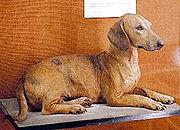
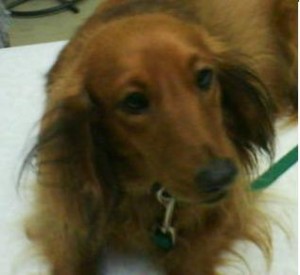
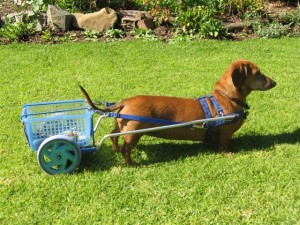

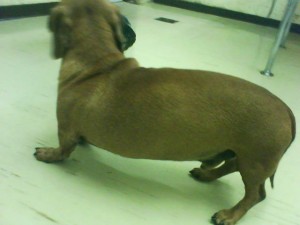
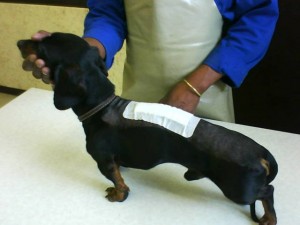
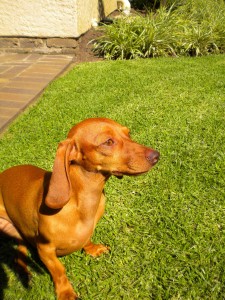
Leave a Reply
You must be logged in to post a comment.